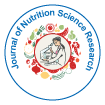Comparative Study for Phytochemical Analysis of Dry Bitter Leaf (Vernonia amygdalina Delile) and Sweet Bitterleaf (Vernonia hymenolepis) leave for their Nutritional and Medicinal Benefits.
Received Date: Apr 07, 2021 / Accepted Date: Apr 14, 2021 / Published Date: Apr 21, 2021
Abstract
Green leafy vegetables together with other components of the plant world are the major source of some phytochemicals (secondary metabolites) that are used by the pharmaceutical and food industries. The focus of this study was to conduct the phytochemical analysis and mineral/elemental composition of Bitter Leaf and Sweet Bitterleaf in Bali as probable justification of their nutritional and medicinal applications. The plant were identified using pertinent taxonomic literature by Garjila (2016). Standard procedures by Trease and Evans (2009), Association of Official Analytical Chemist, Official method of Analysis (AOAC, 2003), Pearson (1976), Lucas and Markakes (1975) and Harbone (1973) were used to analyse the sample for phytochemical compositions. The result of the study shows that Bitter leaf comprise of 13.86% alkaloid, 18.00% flavonoid, 6.00% saponin, 2.34 mg/g oxalate and 16.73% phytate. Sweet Bitterleafhave 8.00% alkaloid, 9.43% flavonoid, 5.77% saponin, 3.60 mg/g oxalate, 40.67% phytate. In conclusion, the two (2) vegetables: Bitter Leaf (VernoniaamygdalinaDelile) and Sweet Bitterleaf (Vernoniahymenolepis) contain varied and appreciable amount of phytochemical constituents (alkaloid, tannins, flavonoids, saponins and protein). Thus, the vegetables may be use as phytochemical supplements and also useful in the management of various ailment and disorders in human
Keywords: Phytochemical, Secondary metabolites, Vegetables
Citation: Ojeaga I, Akuki E, Danladi S (2021) Comparative Study for Phytochemical Analysis of Dry Bitter Leaf (Vernoniaamygdalina Delile) and Sweet Bitter leaf (Vernoniahymenolepis) leave fortheir Nutritional and Medicinal Benefits. J Nutr Sci Res 6: 141.
Copyright: © 2021 Ojeaga I, et al. This is an open-access article distributed under the terms of the Creative Commons Attribution License, which permits unrestricted use, distribution, and reproduction in any medium, provided the original author and source are credited.
Select your language of interest to view the total content in your interested language
Share This Article
Open Access Journals
Article Usage
- Total views: 5651
- [From(publication date): 0-2021 - Nov 23, 2025]
- Breakdown by view type
- HTML page views: 4693
- PDF downloads: 958
